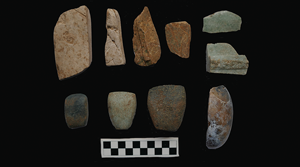No CrossRef data available.
Article contents
Stone on stone: elite involvement in stoneworking at the ancestral Maya site of El Perú-Waka’
Published online by Cambridge University Press: 04 November 2024
Abstract

Crafting is often assumed to have been a ‘dirty’ and hence low-status activity: elites managed the supply of materials or distribution of the products, lower-status workers undertook the hard graft. Here, the authors present an in situ stoneworking toolkit from El Perú-Waka’ in the central Maya lowlands of Guatemala. Recovered from a high-status neighbourhood, the tools indicate the involvement of elite crafters in the working of various types of stone and greenstone. The assemblage is discussed with reference to ontological understandings of raw materials in the Maya world and the importance of specialised and ritual knowledge. The results encourage greater consideration of the involvement of elites in craft production across Mesoamerica and beyond.
Information
- Type
- Research Article
- Information
- Copyright
- Copyright © The Author(s), 2024. Published by Cambridge University Press on behalf of Antiquity Publications Ltd

